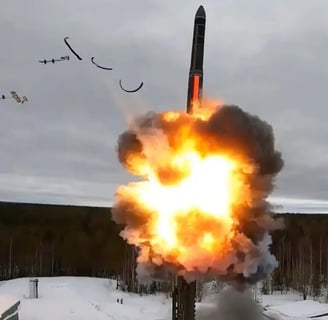Oreshnik Missile: Russia's New Arsenal in Modern Warfare
EDITORIAL DEFENCE


In recent years, Russia has consistently pushed the boundaries of military innovation, especially in missile technology. Among its latest developments is the Oreshnik missile system, a name that has started reverberating in defense circles globally. Derived from the Russian word for "hazelnut," the Oreshnik missile represents a metaphor for its hard-to-crack capabilities and strategic importance in modern warfare. This editorial delves into the development, features, and implications of this advanced missile system in the evolving geopolitical landscape.
The Emergence of Oreshnik Missiles
The Oreshnik missile program was conceived as part of Russia’s efforts to modernize its arsenal in response to shifting global defense strategies and growing threats from NATO's advanced missile defense systems. Spearheaded by Russia's Ministry of Defense in collaboration with leading aerospace companies, the Oreshnik system was designed to ensure precision strikes, evasion of missile defenses, and versatility in deployment.
While specific details remain classified, reports suggest that the system is designed to serve as both a tactical and strategic weapon. It reportedly fills the gap between conventional cruise missiles and Russia's existing hypersonic systems, ensuring adaptability for various mission profiles.
Key Features and Capabilities
1. Precision and Range:
The Oreshnik missiles are equipped with state-of-the-art guidance systems, enabling them to strike targets with remarkable accuracy. The range is speculated to vary between 500 to 1,500 kilometers, making them ideal for medium-range engagements.
2. Stealth Technology:
A standout feature of Oreshnik missiles is their ability to evade enemy radar systems. Using advanced stealth coatings and low-altitude flight paths, the missile can bypass sophisticated air defense networks.
3. Multi-Purpose Payloads:
The Oreshnik system is capable of carrying conventional, thermobaric, and even nuclear warheads, underlining its strategic value. This flexibility ensures its effectiveness against a variety of targets, including fortified bunkers, aircraft carriers, and high-value military installations.
4. Mobility and Deployment:
Unlike many missile systems that require fixed launch platforms, Oreshnik missiles can be deployed from mobile platforms, including land-based launchers, submarines, and potentially even aircraft. This mobility makes the system a formidable tool in Russia's offensive and defensive strategies.
5. Electronic Warfare Integration:
To counteract jamming and electronic warfare systems employed by adversaries, Oreshnik missiles come equipped with robust countermeasure capabilities. These systems ensure uninterrupted communication and targeting precision even in hostile environments.
Strategic Significance
The Oreshnik missile system plays a critical role in Russia's military doctrine, which emphasizes asymmetric warfare and deterrence. Its deployment is viewed as a response to the growing militarization of Eastern Europe, NATO's expansion, and the increasing presence of American missile defense systems in proximity to Russia’s borders.
Additionally, the missiles bolster Russia's nuclear triad by enhancing its second-strike capability. In the event of an attack, Oreshnik’s mobility and stealth make it a survivable and reliable tool for retaliation, thereby maintaining strategic stability.
Implications for Global Security
1. Arms Race Intensification:
The development of Oreshnik missiles has added fuel to the ongoing global arms race, particularly in missile technology. Western nations, especially the United States and its NATO allies, are likely to accelerate the development of countermeasures, leading to heightened tensions and increased military expenditures.
2. Impact on Regional Stability:
The presence of such a versatile missile system in Russia’s arsenal has caused concern among neighboring countries, especially those in Eastern Europe. Nations like Poland and the Baltic states may feel compelled to bolster their defenses, potentially escalating regional instability.
3. Shift in Warfare Dynamics:
The versatility and adaptability of Oreshnik missiles highlight the changing face of modern warfare, where precision, mobility, and stealth take precedence over sheer firepower. This shift compels other nations to rethink their military strategies and invest in similar technologies.
4. Diplomatic Repercussions:
The introduction of Oreshnik missiles could complicate arms control negotiations, such as the New START Treaty, which already faces challenges. As advanced missile systems become more common, reaching a consensus on limiting their deployment might prove increasingly difficult.
Future Prospects
The Oreshnik missile system represents a significant leap forward in missile technology, but it is also a precursor to what might come next. As artificial intelligence, quantum computing, and advanced materials science continue to evolve, future iterations of such missile systems could become even more autonomous, intelligent, and lethal.
For Russia, the success of the Oreshnik program underscores its ability to remain a formidable military power despite economic sanctions and technological embargoes. For the rest of the world, it serves as a reminder of the urgent need for renewed focus on diplomacy, arms control, and conflict prevention.
Conclusion
The Oreshnik missiles encapsulate Russia’s ambition to redefine the landscape of modern warfare. With their unmatched precision, versatility, and stealth, they serve as a testament to Russia’s engineering prowess and strategic foresight. However, their development also raises pressing questions about global security, the arms race, and the future of warfare.
As nations scramble to keep pace, the world must grapple with the dual-edged sword of technological progress—where advancements meant for defense can often become harbingers of instability. In this context, the international community must prioritize dialogue and cooperation to ensure that such technologies contribute to peace rather than conflict.


